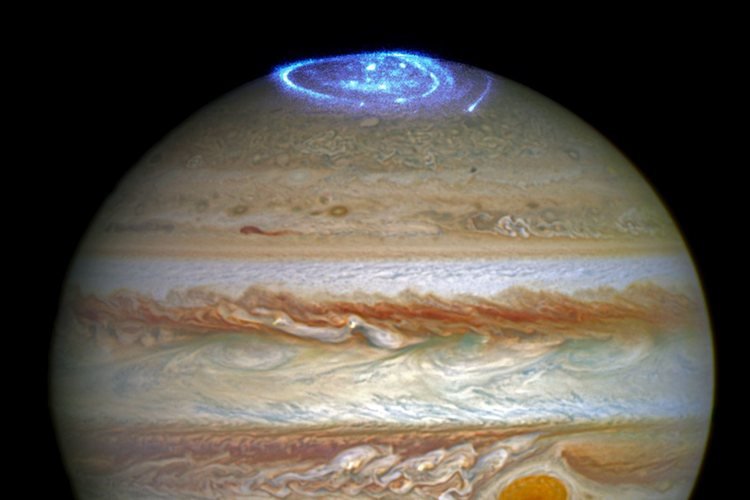An international team of researchers says they have solved the 40-year enigma of why magnificent bursts of X-ray auroras are released every few minutes on the planet Jupiter.
According to the new study published in Science Advances, periodic oscillations of Jupiter’s magnetic field lines are causing these regular bursts of extremely short wavelength, high-frequency electromagnetic radiation near Jupiter’s north and south poles.
The research team led by the University College London and the Chinese Academy of Sciences says these vibrations in the planet’s electric current cause plasma waves to send heavy ion particles “surfing” along magnetic field lines until they collide with Jupiter’s atmosphere, releasing energy in the form of X-rays.
The discovery was made possible by comparing observations by NASA’s satellite Juno, which is currently orbiting the gas giant, with X-ray measurements simultaneously recorded by the European Space Agency’s XMM-Newton Observatory.
“We have seen Jupiter producing X-ray auroras for four decades, but we didn’t know how this happened. We only knew they were produced when ions crashed into the planet’s atmosphere,” said Co-lead author of the study, Dr. William Dunn, in a release by University College London.
“Now we know these ions are transported by plasma waves – an explanation that has not been proposed before, even though a similar process produces Earth’s own aurora. It could, therefore, be a universal phenomenon, present across many different environments in space.”


Like the phenomenon creates spectacular displays of light in the skies near Earth’s high-latitude regions around the Arctic and Antarctic, charged particles within Jupiter’s magnetosphere also produce bursts of visible and invisible light auroras.
Because of Jupiter’s massive size, roughly 318 times larger than Earth, the planet’s magnetic field and magnetosphere are approximately 20,000 times stronger than Earth’s. Likewise, Jupiter’s auroral activity is vastly different and much more powerful than Earth’s. According to data collected by NASA’s Juno spacecraft, a single aurora on Jupiter releases hundreds of gigawatts of energy, or as researcher’s note, “enough to briefly power all of human civilization.”
Because of these marketed differences from Earth, Jupiter’s auroras are not well understood by planetary scientists. In April 2021, researchers from the Southwest Research Institute (SwRI) said they had discovered “new faint aurora features, characterized by ring-like emissions, which expand rapidly overtime” on Jupiter.
Adding to Jupiter’s magnetospheric dynamics, researchers have measured regular bursts of X-ray energy in the planet’s auroras for nearly half a century. Like auroras on Earth, these X-ray emissions appear near Jupiter’s north and south poles; however, they occur with “clockwork regularity,” producing bursts of X-rays every 27 minutes.
Until now, scientists only knew that the ion particles hitting Jupiter’s atmosphere originate from volcanic gas ejected into space from massive volcanoes on the fifth moon out from Jupiter, Io. Collisions with Jupiter’s atmosphere cause the volcanic gas to become ionized, forming a donut of plasma that encircles the planet.
By analyzing continuous observations of Jupiter by Juno and XMM-Newton satellites over 26 hours, the research team says they discovered a clear correlation between plasma waves and X-ray auroral flares at Jupiter’s north pole. Subsequent computer models confirmed the findings, demonstrating that plasma waves would drive the heavy particles towards Jupiter’s atmosphere.


While this recent discovery helps solve the perplexing question of Jupiter’s X-ray auroras, Earth’s 365 million to 601 million mile neighbor (depending on each planet’s current elliptical orbit) still holds plenty more mysteries.
For one, scientists aren’t entirely sure why Jupiter’s magnetic field vibrates at regular intervals in the first place. One theory is the vibrations are resulting from interactions with solar wind or high-speed plasma flows within Jupiter’s magnetosphere.
Regardless, researchers say there is cause for some excitement in solving Jupiter’s 40-year X-ray mystery.
“Now we have identified this fundamental process, there is a wealth of possibilities for where it could be studied next. Similar processes likely occur around Saturn, Uranus, Neptune, and probably exoplanets as well, with different kinds of charged particles’ surfing’ the waves,” said Dr. Zhonghua Yao of the Chinese Academy of Sciences, Beijing, and co-lead author of the study.
“X-rays are typically produced by extremely powerful and violent phenomena such as black holes and neutron stars, so it seems strange that mere planets produce them too,” adds co-author and professor at UCL Mullard Space Science Laboratory, Dr. Graziella Branduardi-Raymont.
“We can never visit black holes, as they are beyond space travel, but Jupiter is on our doorstep. With the arrival of the satellite Juno into Jupiter’s orbit, astronomers now have a fantastic opportunity to study an environment that produces X-rays up close.”
Follow and connect with author Tim McMillan on Twitter: @LtTimMcMillan or encrypted email: LtTimMcMillan@protonmail.com

